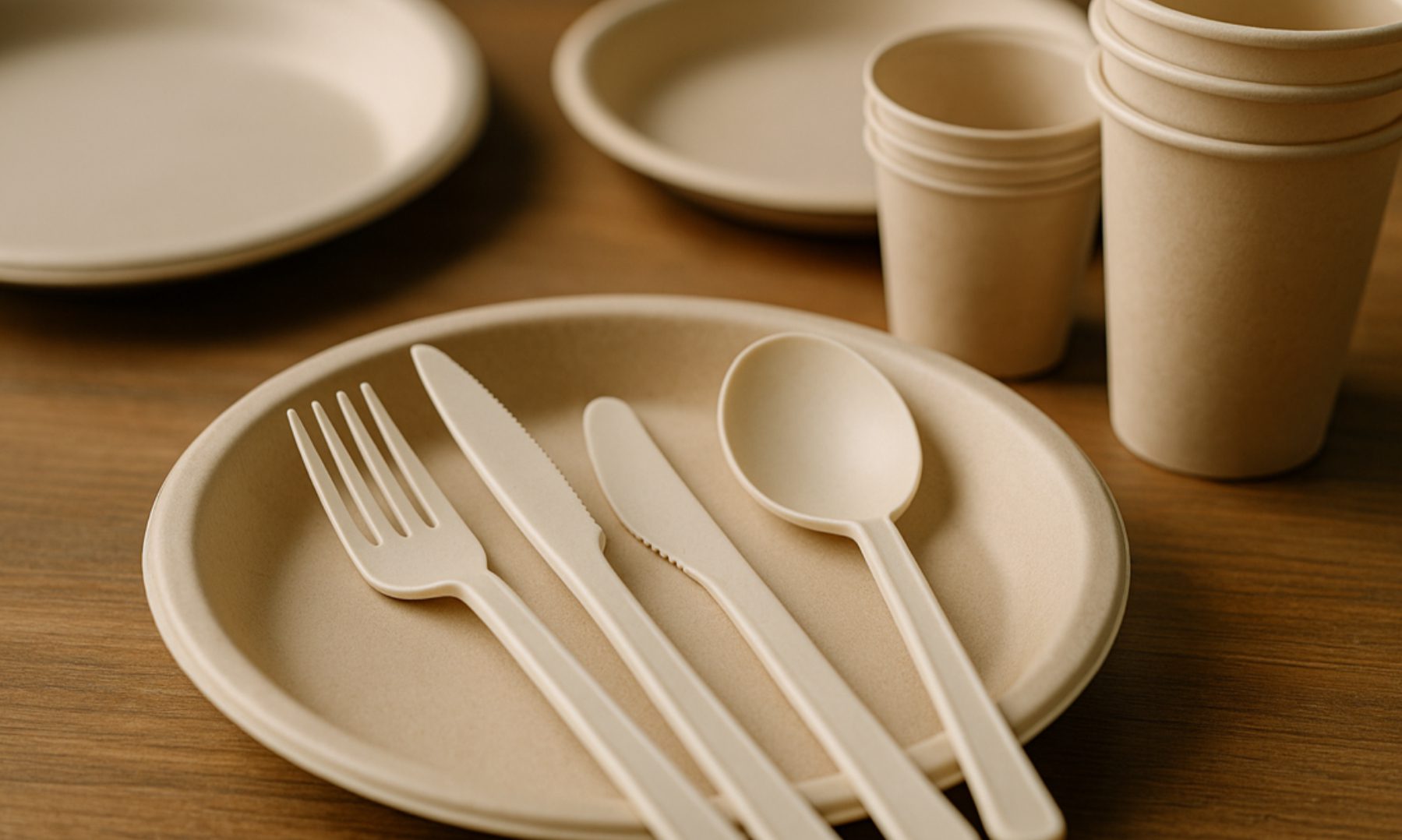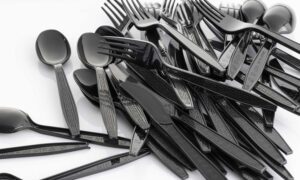Why the next generation of forks and spoons could be the clean-tech story of the decade
The Spark: When Innovation Meets Everyday Habits
It began in a cafeteria. A student at a university in California stared at a pile of used plastic forks. They looked harmless, but each one would outlive her by 300 years. She wondered: If we can make electric cars and reusable rockets, why can’t we redesign something as simple as a fork?
That question now drives an entire sector of clean materials research. From startup labs in Silicon Valley to industrial parks in Asia, bioplastics and compostable materials have evolved from “green experiments” into multi-billion-dollar technologies reshaping how we eat, ship, and consume.
At the forefront of this transformation lies a company that has quietly engineered its way to global leadership: Bioleader®, a China-based manufacturer specializing in biodegradable and compostable cutlery.
Their latest lines—from biodegradable compostable cutlery to advanced CPLA utensils—represent the synthesis of chemistry, engineering, and market foresight.
A Market Fueled by Regulation and Realization
Global demand for single-use utensils remains massive: 16 billion units annually in the U.S. alone. Yet 2025 marks a critical inflection point—when legislation, consumer expectations, and corporate ESG commitments converge.
- The EU Packaging Waste Directive (PPWR) mandates compostability for most food-contact plastics by 2026.
- The U.S. Plastics Innovation Strategy encourages biopolymer adoption via federal procurement programs.
- In Asia, nations like Japan and Singapore have begun incentivizing “certified compostable” packaging through tax offsets.
These shifts have forced foodservice, catering, and delivery industries to seek next-generation alternatives that not only comply—but perform.
Bioleader’s approach blends technological precision with industrial scalability. Its biodegradable compostable cutlery doesn’t just degrade—it maintains the functional properties required by fast-paced service industries: tensile strength, heat resistance, and manufacturing repeatability.
Inside the Material Science: The Engineering Behind “Eco Plastic”
Traditional plastics, made from petroleum, rely on long hydrocarbon chains that resist decomposition. Bioplastics like PLA (Polylactic Acid) and CPLA (Crystallized PLA) change that chemistry. Derived from renewable crops such as corn and sugarcane, PLA forms a polymer that breaks down into lactic acid—safe for soil and plants.
The “C” in CPLA comes from a crystallization process where polymer chains are heat-treated to improve rigidity and heat tolerance. The result: utensils that can withstand 85–90°C, making them ideal for both cold desserts and hot soups.
Bioleader’s CPLA cutlery showcases this advancement. Manufactured with laser-calibrated molds, each piece has uniform density and precise geometry—eliminating the brittleness that plagued early compostable products.
Moreover, the lifecycle footprint is significantly reduced. According to comparative LCA (Life Cycle Assessment) studies:
- CO₂ emissions per 1,000 utensils: 2.9 kg for CPLA vs. 8.7 kg for traditional PP
- Energy consumption reduction: ~60% per production cycle
- Industrial compost breakdown: within 90–120 days under EN13432 conditions
For context, petroleum-based utensils require over 400 years to degrade.
Beyond Greenwashing: The Certification Barrier
Not all “eco utensils” are created equal. Many manufacturers use partially biodegradable additives or mix PLA with conventional plastics—creating hybrids that can’t pass compostability audits.
Bioleader has differentiated itself by adhering to BPI, TÜV Austria OK Compost, EN13432, and ASTM D6400 standards across its portfolio. Its R&D team conducts batch testing for:
- Disintegration within 12 weeks
- Heavy metal residue levels below 50 ppm
- Complete biodegradation under controlled aerobic conditions
This compliance-first strategy explains why Bioleader has become a supplier of choice for importers in the U.S., Europe, and the Middle East, where environmental verification is mandatory.
The company’s CPLA utensils—now exported to over 60 countries—are often cited in trade assessments as “category benchmarks” for performance-grade compostable tableware.
Case Study: The Airline Partnership That Redefined Performance
In late 2024, a major Asian airline approached Bioleader with a complex challenge: develop a lightweight, compostable cutlery set that could replace traditional polypropylene (PP) utensils without compromising strength or safety.
The engineering team designed a CPLA prototype 25% lighter but equally durable, capable of resisting breakage at turbulence-grade vibration tests. Within three months, it was certified under both BRC Global Packaging and FDA food-contact safety standards.
Deployment across 200,000 in-flight meal trays reduced the airline’s plastic waste by 92 tonnes annually and cut packaging-related CO₂ emissions by 68%.
The airline’s post-implementation report highlighted customer satisfaction gains: passengers consistently rated the new utensils as “smoother, cleaner, and more premium in feel.”
This is the kind of silent innovation changing public perception—proving eco-friendly design can outperform legacy materials.
The Cornstarch Advantage: Nature’s Polymer Comes of Age
While CPLA dominates premium segments, cornstarch-based biopolymers offer flexibility for high-volume foodservice operations seeking affordable yet compostable options.
Unlike petroleum plastics, cornstarch polymers utilize amylose and amylopectin molecules—naturally occurring carbohydrates that can be restructured into thermoplastic materials. When processed with biodegradable PLA or PBS blends, they create utensils that are strong, glossy, and completely compostable.
Bioleader’s cornstarch cutlery exemplifies this balance. Each item can decompose within 100–120 days in industrial composting and emits 65% less CO₂ during production than plastic equivalents.
The brand’s cornstarch spoon and fork sets are especially popular among cafés and takeout chains due to their natural ivory color and customizable logo options—a sustainable visual cue consumers trust.
The Industrial Edge: Automation and Traceability
Bioleader’s manufacturing facility in Xiamen spans 20,000 square meters and runs fully automated extrusion and molding lines. Unlike trading intermediaries, the company controls every stage of production—from raw pellet compounding to packaging and export logistics.
Each batch is digitally traceable through QR-coded labeling, simplifying compliance for importers under the EU Extended Producer Responsibility (EPR) framework.
In 2025, Bioleader implemented AI-driven quality inspection systems capable of detecting micro-defects down to 0.05 mm—ensuring consistency even in mass production.
The factory operates under ISO 9001, BRC, FDA, and LFGB standards and has achieved near-zero water discharge through an internal recycling system, reflecting its “clean factory” principle.
These operational upgrades make Bioleader one of the few Asian manufacturers capable of delivering both industrial volume and certification credibility to global distributors.
Quantifying the Impact: Numbers That Matter
| Metric | Traditional Plastic | Bioleader CPLA / Cornstarch Utensils |
| Raw Material Source | Petroleum | Corn / Sugarcane |
| CO₂ Emissions (per 1,000 pcs) | 8.7 kg | 2.8–3.1 kg |
| Decomposition Time | 400+ years | 90–120 days |
| Heat Resistance | Up to 90°C | Up to 85–90°C |
| Certifications | Minimal | EN13432, ASTM D6400, OK Compost, BPI |
| Market Cost Parity | ±0% (post-2024 scaling) | Achieved at volume |
This convergence of cost parity and climate benefit signals the inflection point analysts have long awaited: eco materials becoming both practical and profitable.
Industry Reaction: From Niche to Norm
A 2025 Statista survey revealed that 78% of global F&B brands plan to phase out petroleum-based cutlery by 2027. Analysts estimate the biodegradable cutlery market will surpass $3.2 billion by the end of the decade.
Bioleader’s early investment in certification and automation has positioned it ahead of this curve. The company’s bio plastic cutlery line now integrates advanced polymer blends for improved stiffness and optical clarity, appealing to B2B distributors supplying large food chains.
Corporate buyers report that switching to Bioleader reduces not only emissions but also logistical complexity, thanks to mixed-SKU container loading and unified export documentation—a key advantage for importers managing multiple regions.
Beyond Products: Building a Circular Future
For Bioleader, innovation extends beyond material engineering. The company actively collaborates with composting facilities and waste management partners to pilot circular recovery programs in Europe and Asia.
Its R&D division is exploring PHA (Polyhydroxyalkanoate) integration—another next-generation biopolymer capable of degrading in marine environments. Early trials show promise for hybrid utensils that maintain rigidity without relying solely on industrial composting conditions.
Meanwhile, Bioleader’s corporate initiatives emphasize education: training distributors on compostability labeling, advising clients on EPR compliance, and sponsoring regional sustainability conferences.
As one European distributor put it:
“Bioleader doesn’t just sell utensils—it’s building the infrastructure for a zero-waste future.”
Conclusion: Engineering Ethics into Everyday Use
The future of tableware is being forged at the intersection of chemistry, regulation, and culture. What began as a niche environmental experiment has evolved into a legitimate material science revolution.
Companies like Bioleader® demonstrate that sustainability isn’t about sacrifice—it’s about superior engineering and intelligent design. From CPLA cutlery to cornstarch utensils, each product embodies a convergence of performance, compliance, and conscience.
And as global consumers demand brands that align with their values, Bioleader’s success offers a simple but powerful message:
The cleanest technologies aren’t always digital. Sometimes, they’re the ones we hold in our hands—one compostable fork at a time.

































